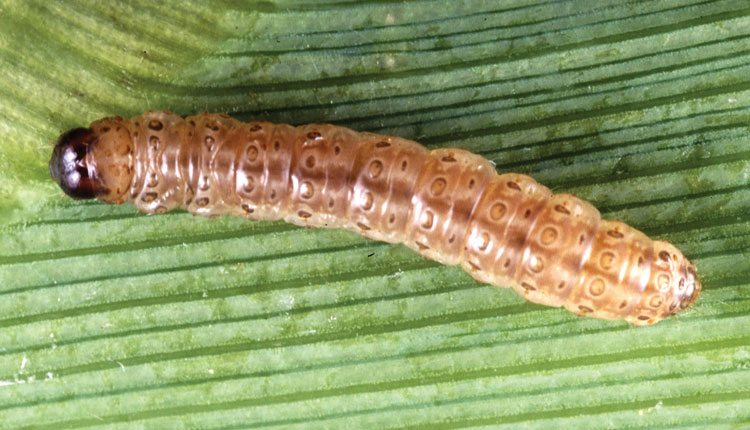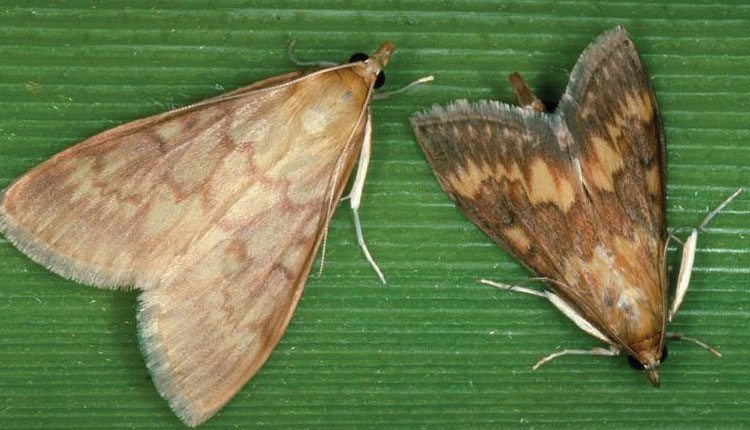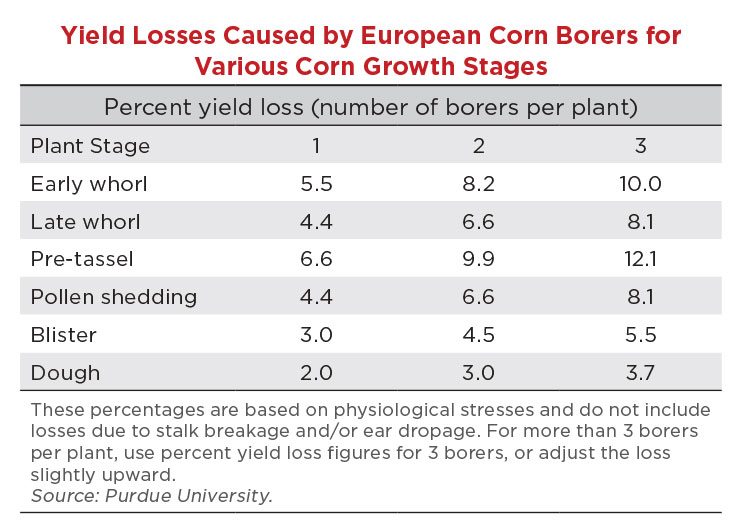With the ever-evolving nature of insects, companies are challenged to come up with an arsenol of traits and seed-applied technologies to help farmers win the battle season after season.
With more than 88 million acres of corn planted in 2015, insects that feed on this staple crop had plenty to sink their chewing mouths in.
While much of farmers focus these days is on getting herbicide-resistant weeds under control, experts remind not to forget about developing a management plan for insects as well, so as not to end up in a similar situation.
When coming up with an insect management plan, it’s important for agronomists, crop advisors and farmers to consider both above- and below-ground insects. These include European corn borer, corn earworm, cutworm and corn rootworm.
“This year, European corn borer has been a really big issue,” says Iris Tzafrir, Syngenta commercial traits lead for corn, noting that 2015 might have seen some of the worst population numbers in the past 15 years. “Reports have been particularly bad in Minnesota and South Dakota.”
European corn borer damages corn when the boring disrupts the plant’s vascular tissues and interferes with the internal transfer of water, sugars and nutrients, according to Iowa State University’s Department of Entomology. Additionally, some infectious diseases can establish after borer damage.
Tzafrir says growers have been making use of Bt traits but due to lower commodity prices, might have opted to plant conventional varieties this year.
She explains that because traited products have been so successful in protecting the seed and corn plant from insect damage, growers might have had a false sense of security and not realized the pest pressure that exists in their fields.
“Bt traits have been doing a tremendous job on the market,” Tzafrir says.
She cautions growers and says just because you can’t see it, and it’s not an issue today, doesn’t mean that it’s not going to be an issue in the future.
“We need to manage with this in mind,” she says. “If we don’t start developing long-term management plans, what we are seeing with European corn borer and farmers’ decision to purchase conventional hybrids for a cost savings could end up costing them more in the end because of crop damage and yield loss.
“We advise growers to really tailor their product selections to the problems or insects they have in their field.
There are options that allow for more flexibility when it comes to pricing. For example, there’s a price difference between structural refuge and integrated refuge, she says.
“They are both good products that help to protect yield,” she shares, noting that the integrated refuge is convenient but the convenience costs a little more.
In fields that have high insect pressure, choose a product with multiple modes of action for above- and below-ground insects.
In managing this year’s pests, it is also important to think about what might be a problem next year. You need to understand what’s going on in a field and plan accordingly.
“Every field is different and every operation has different needs,” she says. “That’s how we as an industry need to think about helping growers address needs.”
In addressing needs for the 2016 growing season, Ken Ostlie, a University of Minnesota Extension entomologist, says the first thing to consider when selecting a corn hybrid is yield potential.
“Bt traits only provide a yield benefit when targeted insects are above economic levels,” he says. “When insect pressure is low, any potential yield gains of newer, trait-protected hybrids have to be balanced against their higher costs.
“A more important consideration may be limited availability of high-yielding non-Bt or single Bt trait corn hybrids.”
Ostlie says pressure from corn borer might be higher in areas where significant amounts of corn without Bt corn borer traits were planted.
Experts at Iowa State University report that when European corn borer is present, it’s usually not the only pest.
However, he says risk can be reduced with scouting and applying a labeled insecticide where needed.
To determine if treatment of European corn borer is economically justified, John Obermeyer, a Purdue University Extension entomologist, recommends using the following steps:
1. Calculate preventable yield loss (anticipated yield multiplied by yield loss figure from the table multiplied by the level of infestation multiplied by the level of control). It is probably impractical to expect 100 percent control. A good estimate of control might be 75 percent, he says.
2. Calculate preventable dollar loss per acre (preventable yield loss multiplied by market value).
3. Compare preventable dollar loss per acre to the cost of insecticide application to determine if treatment is warranted.
In the Corn Belt, most growers have experienced light corn rootworm pressure.
The other thing to remember, according to Tzafrir, is that “pests are not gone, they need to be continuously scouted for and managed.”
In the case of corn rootworm, she recommends assessing beetle populations in the fall, which are a good indicator of what the pressure might be in the following growing season.
She encourages those who work with growers to think about how to best manage for a three- to five-year period versus managing pests year-to-year.
“This is not so easy to do,” she says. “If a farmer has high pressure this year, next year could be different.
“Traits protect your investment in genetics. You really want to protect the genetics and that means yield potential and profit potential.”
— Iris Tzafrir
Syngenta started offering traits in 2004 and has since come a long way.
“There’s been an enormous amount of productivity [when it comes to offering traits] and thinking ‘how can we support growers,’” Tzafrir says.
On this note, Syngenta launched Agrisure Viptera, a trait that addresses above-ground insects.
This trait features a unique protein generated by bacteria in its vegetative growth stage. This protein was first isolated from spoiled milk.
Since its launch, Agrisure Viptera has been incorporated into a suite of products. Tzafrir says it protects against a number of pests and is also known for preserving grain quality because it reduces the amount of aflatoxin in the grain by controlling insects whose feeding opens the door for mycotoxin development.
“It’s not just about quantity, but quality,” she says.
Looking to the future, Tzafrir says researchers are working on a number of projects that are still 10 to 15 years out — the early stages of pipeline development — that will address these pests. Some of these include new proteins and other biological approaches such as rNAI.
Seed Treatments
Traits aren’t the only tool available to farmers to protect yield. Seed treatments also help protect yield by ensuring plants are protected during the early stages of development.
One of the newest seed treatments to hit the market in this area is Bayer CropScience’s Poncho/VOTiVO, which is designed to protect the whole plant, above and below ground. It uses a biological mode of action with a bacteria strain that lives and grows with the young roots, creating a living barrier that prevents nematodes from causing damage.
It also has a systemic agent that’s absorbed by new roots and provides control of many early-season insects. It has been approved for use on corn to control wireworm, Southern corn rootworm, a host of nematodes, seedcorn maggot, corn flea beetle, corn leaf aphid, among many others.
According to Bayer, over a four-year trial, Poncho/VOTiVO delivered a 5.4 bushel per acre yield increase compared to Poncho 250.
A Future in Biologicals
While both Bt and Poncho/VOTiVO are considered biologicals, Brad May, Bayer CropScience SeedGrowth strategic business lead, says that this is only the beginning.
“Biological seed treatments have so much potential,” he says. “We are just beginning to understand what they are capable of doing.”
Biologicals are one more option that seed and chemistry companies can look at to add solutions to a grower’s toolbox.
“The more options a grower has, the better,” May says. “Biological seed treatments could diversify the current integrated pest management toolbox and even provide unique advantages over traditional crop-protection products.”
For example, biologicals target a single group or species of pests but have a low environmental impact. Some biologicals have the ability to live and grow with the plant, extending pest protection.
As seed treatments and crop protection products come under increased scrutiny, those within agriculture must adapt and look for innovative solutions to maintain the yield gains realized to date.














